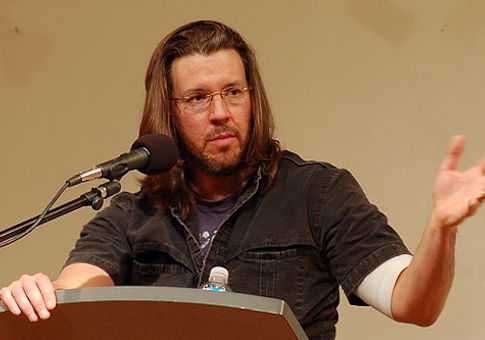I am not a big fan of David Foster Wallace. I can’t finish Infinite Jest, his repetitive, sprawling novel in which minutely described scenes never seem to evoke a complete image or create a connected plot, and I’m not particularly interested in his life, which he tragically ended by hanging himself from his patio in 2008.
Still, a posthumous collection of his tennis essays, published last week by the Library of America, caught my eye. I grew up playing and watching tennis and enjoyed (with some caveats) Wallace’s essay on the Maine Lobster Festival and his now over-discussed commencement speech at Kenyon College, but I had never read his tennis pieces.
Wallace was, as he puts it, a "near-great junior tennis player" in his teens in Illinois. While he stopped playing competitively after college, he would continue to hit the ball "seriously" for much of his life and watched the sport on TV and live. He wrote about tennis (which also figures in Infinite Jest) more than anything else beside himself—not that the two are always easy to disentangle. String Theory collects his five essays on the sport, published between 1991 and 2006, all of which have been previously collected.
The first is a slog. "Derivative Sport in Tornado Alley" revisits Wallace’s experience playing tennis in the windy Midwest. While not a particularly gifted player—or so he claims—Wallace found success on the court because of his "robotic detachment" from the capricious wind. His ability to take it into account in his calculation of angles allowed him to upset players with more talent and panache—at least until they began to grow while he remained trapped in a boy’s body.
The frustration that other players felt while playing in the wind, the young Wallace began to feel when he faced increasingly taller and more powerful opponents. "I began," he writes, "to resent my physical place in the great schema, and this resentment and bitterness, a kind of slow root-rot, is a big reason why I never qualified for the sectional championships again." The essay suggests that tennis is a metaphor for life, and it’s a rather ominous one at that. Some people, unable to handle life’s seeming unfairness, just give up.
This is fine as far as it goes. The problem is that to get there we have to work through some pretty long asides, confusing metaphors and similes (Is tennis "to artillery and airstrikes what football is to infantry and attrition?" Can you have a "king-vs.-regicide dynamic"?), occasional typos, repetitions, and tortured syntax ("The same soil that’s so full of humus farmers have to be bought off to keep markets unflooded keeps clay courts chocked with jimsona and thistle and volunteer corn, and it splits asphalt courts open…").
These shortcomings are exacerbated by the decision to use the version of the essay that appeared in his 1997 collection, A Supposedly Fun Thing I’ll Never Do Again, rather than the more carefully edited one that appeared in Harper’s in 1991 under the title "Tennis, Trigonometry, Tornadoes." In the Harper’s version, entire paragraphs are struck, clunky syntax is fixed, metaphors are revised for clarity, and details are cut to improve pacing. I’m not sure why the editors of String Theory decided to use the 1997 essay—perhaps there’s a financial reason—but no explanation is offered.
While the other essays are slightly longer (and less edited) than the magazine versions, they are, thankfully, much better than the first one. When Wallace reins himself in, he can be a charming guide who can identify the strangeness or sadness of seemingly pedestrian events with an eye for telling details. His essay on Michael Joyce and what it’s like to play the qualify rounds of a major tennis tournament introduces us to the world of second- and third-tier tennis pros—a strange one of unexpected contrasts of wealth and poverty, mindlessness, and physical beauty.
Wallace has a talent for commenting on the action of a game and describing the players. Marc Rosset and Jacob Hlasek move with a "compact nonchalance." When they are working out, they are like "a very powerful engine in low gear." Richard Krajicek plays "like a rabid crane." The purpose of "extreme daily practice" for talented junior players is to refine "the kinesthetic sense" so that they can play almost without thinking.
But he can also exaggerate. There’s always a bit of fudging, perhaps, conscious or not, in all writing, but if you lose credibility with your readers as an essayist, you’re toast. Wallace, for example, explains how some mothers would wail at tennis matches and "clutch childish heads to their bosoms" when there was a tornado warning. A paragraph later, he writes: "Watches and Warnings both seemed to have a kind of boy-and-wolf quality for the natives of Philo. They just happened too often." The wailing seems a touch overdone.
Worse, in his essay on Roger Federer, which may be the best in the volume, he opens with a long description of what he calls a "Federer Moment," which is when the Swiss player makes a shot that seems impossible. Federer is serving, up two games in the fourth, and Wallace description of what follows is almost entirely false. He tells us that after Federer hits a return, he scrambles "to reverse and get back to center." He doesn’t. Agassi does not move in "to take the ball short," nor does he "smack it hard." Agassi does not follow his shot to the net. Federer does back peddle, but not "impossibly fast," as Wallace tells us, and while he hits a winner down the line—a difficult shot, no doubt—it is hardly amazing by professional standards. The crowd does not "erupt." The shot is not "like something out of The Matrix" (which by 2006 was already a cliché).
In short, Wallace’s essay game lacks the consistent elegance and truth of the greats. There are spots of real entertainment and skill in String Theory, but it’s no Levels of the Game.
